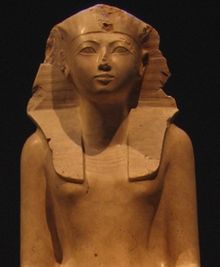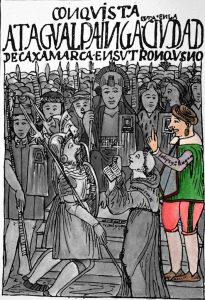Winner of the Fall 2016 StMU History Media Award for
Best Introductory Paragraph
Article with the Best Title
Queen B said it best when she sang the infamous line, “Who run the world? Girls.”1 When looking back to history, men are seen as better and treated better than women. A long time ago, in ancient Egypt, women of the royal family served as guides to young male rulers. But there was one unconventional case where a woman defied the odds and obtained the role of pharaoh.

Queen Hatshepsut was the oldest daughter of Thutmose and his Great Royal Wife, Queen Ahmose. Thutmose, like most males who held power during those times, had another wife with whom he had a son. His name was Thutmose II; when he was at the age of eight and Hatshepsut was thirteen, they were wed, despite the fact of their shared blood line. When their father passed, Thutmose II assumed the position of pharaoh. While he was pharaoh, they birthed a daughter, but every male in power needs a male heir. Since she was unable to produce a son, he and a minor wife, Iris, conceived a son who became Thutmose III. Thutmose II and Hatshepsut reigned in Egypt until his death. The next male in line was Thutmose III, but Hatshepsut’s step child was too young to fulfill the position of pharaoh, so she ruled in his stead. On that note, even when he did become old enough to rule, she refused to turn over the power to him, and she remained in power. That is when she began her transition from Queen Hatshepsut to Pharaoh Hatshepsut.2

The Queen herself had a headdress made that included a beard and some male characteristics.3 She did not go out of her way to keep her gender a secret, for she did include feminine touches to her attire. Masculinity of course was respected more and was associated with power, which is why she sometimes took on such characteristics. Despite being a female ruler, at that time (and still today) people would not expect such a flourishing reign. Beginning in 1473 B.C.E. and ending in 1458 B.C.E., under her control wealth was accumulated. When it came to the protection of Egypt, she engaged in successful warfare against her invaders. She also had an extensive building program in which a temple of devotion to their sun god, Amun, was erected. Prosperity and wealth also came about because she sent ships on expeditions to foreign lands to obtain riches. These included ivory, ebony, gold, and trees. Now, why would they bring back trees? Whenever they had temple ceremonies, trees would be burned by the tons for fragrant incense.4
All good things must come to an end, and this particular ending is death. After she died, successors attempted to erase the fact that a female had become pharaoh.5 Even with this attempt to erase history, she is still known as a successful pharaoh to this day. She brought about protection, prosperity, and plenitude during her time as king. She did not serve as a guide to a young male pharaoh, but she showed how one must rule during her reign.
- Beyoncé, “Run the World (Girls),” in 4, Columbia Records, 2011. ↵
- Ann Macy Roth, “Models of Authority: Hatshepsut’s Predecessors in Power,” in Hatshepsut: From Queen to Pharaoh, ed. Catharine H. Roehrig, Renee Dreyfus, and Cathleen A. Keller (New York: Metropolitan Museum of Art, 2005), 10. ↵
- Roth, “Models of Authority: Hatshepsut’s Predecessors in Power,” 10. ↵
- Rupert Matthews, DK Eyewitness Books: Explorer (DK Publishing, 2012), 8. ↵
- Angela Murock Hussein, “Legacy of a Female Pharaoh,” Calliope 19, no. 1 (September 2008): 48. ↵



85 comments
Christopher Metta Bexar
The article is thought provoking as well as something different. Of course it was common for brothers and sisters to marry and have children. Who else but the sister of Pharaoh was royal enough to marry him and bear his children?
And it won’t be the first time an older girl will marry a younger boy. Catherine of Aragon was 16 when she married the 11 year old Henry [ prince of wales] who would become Henry VIII.
Samantha Ruvalcaba
Fist of all, love, love the Beyoncé reference! It made me much more excited to read this article. I’m glad to have read about a woman who felt like she could rule just as well–if not better–than a man could and proved it. It’s always fascinating to read about those rare cases in which traditions weren’t always upheld and went against status quo.
Ruby Wynn
This is a very interesting article. It is crazy that a thirteen year old girl would be married to her eight year old step brother. It seems like Hatshepsut had been waiting for the opportunity to become pharaoh for a long time. She had to with for her father and step brother/husband to pass before she could become pharaoh, so it makes sense why she wouldn’t want to give up the power to her stepson when he came of age.
Andres Cano
Hatshepsut surely made a huge step in the right direction for her country, but she also made a statement for women in Egypt during the time of her rule that lasted (and still lasting). I always knew of Hatshepsut as arguably the most dominant woman ruler of all time, but I think it’s even more significant because she preceded Thutmose III, who was arguably one of the most dominant male rulers of all time. It makes you think that a lot of his leadership skills were “inherited” since he was not directly related to her, but it still says a lot because she was the reigning ruler that he must have looked up to while he essentially waited for her to pass so he could take over.
Eric Ortega Rodriguez
For thousands of years, the idea of a man being superior to women has been relevant. Queen Hatshepsut proved that this is not the case at all, she demonstrated that women can achieve anything a man can do and even in some cases can do more. What I found crazy is that she put on a beard to appear more dominant among the public. Overall, this is a very good topic selection.
Victoria Salazar
Wow. Great article. I have always seen cool statues of Pharaoh Hatshepsut but never thought much about it. I think one of the best parts about her reign was that she must have carried herself in such a way as to not have had too many people oppose her rulings. Everyone has enemies, but her long, successful reign goes to show how much her people admired her.
Gabriel Dossey
I love this story. I really think that it is sad that in death she was erased from the history books as a woman and that only now we can appreciate her. I also find the fact that she crossdressed was interesting. Congrats on the win and keep up the good work.
Diego Aguilera
Great article and I love the descriptive the author uses. I think its funny how she refused to turn over the power to her stepson and turned out to be a great and successful Pharaoh. I also liked how you started the article with an empowering quote from a very well known artist who also shows her fans that women can run the world. Overall Hatshepsut’s legacy shows how women can be successful and that men hold no more power than women.
Damian Jennings
To see a women ruling over a great city is remarkable and shows how far women have come, they were stepping up and partaking in big roles to show that they are equivalent to men. They are just as capable of doing the task of men, and she showed the city her capability to rule. Even if she was falsy portraying herself as a man, she was a biological women
Sebastian Carnero
It is great how she stood against some of the traditions and what many thought. Her rise to power was a very interesting case, she took the place of her husband and she maintained the power according to her own judgment. It was a good thing that her successors couldn’t erase her feats. She contributed in temples, trade, exploration and managed warfare properly. Hatshepsut did what she needed to do, she did it well and she maintained her beliefs while ruling.